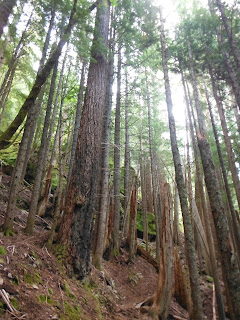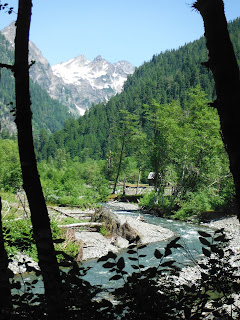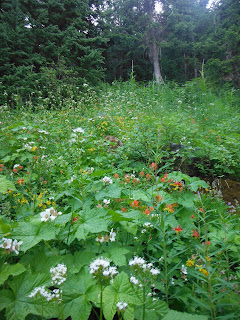 |
| Your Destination, the top of Mt. Dickerman, still 800 vertical to go! |
Woke up yesterday to a heavy marine overcast in the lowlands, so I considered changing my hike to a lake or waterfalls. After all, summit hikes are a little pointless if the peak is socked in. However, the purpose of this hike was primarily conditioning for a later backpacking trip in August, so I decided to stick with Mount Dickerman. It turned out to be a great decision. By 10 AM, the clouds had burned off, and on top, it was absolutely glorious with views from Baker in the North to Rainier in the South.
The trail is fairly rugged in places with rocks, roots and a couple of easily maneuvered blowdowns. The little streams and cascades that cross the trail are mostly dry now. There's really no safe and easy way to filter water on the hike. Bring plenty of water with you.
 |
| The Woods are lovely, dark and STEEP! |
Along the way, I passed a few people struggling somewhat on the trail. I think folks, perhaps new to hiking, don't recognize the fitness level required to enjoy a trek of this rigor. Build up to it with less aggressive day hikes. I would suggest hiking Lake 22, or Lake Annette then heading up to Pilchuck, etc. If you can hike a trail of week, and make each one a little more challenging, in a matter of weeks, a grade like Dickerman will feel like work, but not a death march.
 |
| About 45 minutes into the woods,finally a viewpoint |
The Mt. Dickerman trail is steep for the first hour through the woods. It flattens out for a short section, then gets steep again near the summit. Nearly 4,000 feet of elevation gain over four miles is a lot work, especially on less than perfect trails. For comparison, Mount Si climbs 3150 feet over the same distance, and people call it "a slog." My friend, Ernie, the Calculus teacher informed me that the Dickerman trail has 55 switchbacks. I have not counted them, but I trust his numbers.
 |
| The trail flattens out in the middle |
On trail with me yesterday morning was a scattering of ten or so older and wiser hikers who knew to start early before the blazing sun begins to roast everything on the southern slope. Most of the people on the trail were also Seattleites who had headed north to the Mountain Loop Highway because of growing mobs on Snoqualmie Pass trails. I suppose in five years, crowds will hover around Mt. Dickerman like they do around Mt. Si.
A bear had been reported on the mountain earlier in the month. More than half way through the woods, I was stopped by a dark stirring in the vinemaples, very reminiscent of my last bear encounter on the shoulder of Mt. Baker last summer. I paused, and raised my trekking poles to clang them together. I turns out my bear was a rather petite woman, returning from a call of nature. She looked at me aghast. I told her, thinking of an old Remington drawing, "I took ye for a bar."
She growled at me. I certainly didn't mean to compare her features to a bear: she would have been more of a petite cub, but the rustling in brush gave the effect of a bigger bruin.
A couple of women further on trail took exception to my comparing Mt. Dickerman to Mt. Si.
"I am not sure how they are even in the same paradigm," one scolded me. My point, of course, was Mt. Dickerman was well worth the extra work.
Another of my fellow travelers was a retired Medieval Literature professor, 12 years my senior. He made slow and steady progress up the slope, summiting perhaps 45 minutes after me.
 |
| Mount Rainier beyond Big Four |
Only few folks had been to the top that morning before I arrive. One was a trailrunner who was up and down in probably 3 hours. He was 2 1/2 hours on the trail 3/4th done when I met him.
 |
| Baker to the North |
Closer to the top, a friendly millennial told me to look for a mountain goat 100 yards from the summit. I was excited to see mountain goats for the first time in two year. Sadly, the old billy must have moved off, for I never saw the goat, or a real bear on that mountain this trip.
 |
| Bear grass, lupines, asters, and Julie Andrews |
I must be getting closer to mid-summer form, because it took me a little over 2 hours to reach the summit. The views and blues were awesome. In other words, haze hadn't altered the color of the sky, and visibility went for 100 miles north and south. To the east, Glacier Peak sits just 12 crow miles away. I like to move to the eastern edge of top ridge, where I can almost touch the mountain as I eat. Three or four swallows were practicing acrobatics above me. As they jet past, I could hear the very audible swoosh of wind over their wings.
 |
| Glacier Peak |
It turns out my favorite spot on the ridge is precisely where the professor likes to end his weekly pilgrimage to the mountain, and snooze for awhile. He mentioned that I stole his spot, but my meal was nearly over when he arrived, and I told him I was getting ready to head down. He unrolled his sleep pad to prepared for his siesta at elevation. As I was packing up, we conversed a bit more about teaching. It turns out that he and I had a least one student in common, Johanna, who ultimately became a colleague of mine.
The professor told me Johanna was "bright, a spark, and a real go-getter."
"Absolutely!" I agreed and gave him an update on her life. I think we were both happy about the our small world moment. Hopefully, he slumbered to memories of a time when the humanities seemed to matter more in America.
As I wondered back across the summit ridge, I said hello to folks I had met on the way up.
Bearwoman gave me a friendly growl, and the other women reminded me how the view was so much better here than on Mt. Si. I tried to again to agree with her, as I had earlier: the payoff for Dickerman is greater than any other hike of the same effort in the region. She wouldn't let me--she needed a strawman, and I was it. Certainly, once you break out of the woods, the meadows are teeming with wildflowers, and on top, nearby Glacier Peak holds court over the Central Cascades.
Reluctantly, I headed back down after enjoying a leisurely lunch on top. At my age, I nearly always hike with trekking poles. The steep up is a steep down, with ankle-rolling rocks and roots all the way to the trailhead. Enjoy the hike, but bring plenty of water and your trekking poles.
EPILOGUE: When I got home, I texted Johanna about my chance meeting with her old professor. She told me she was flattered that he remembered her after 17 years. She said he led hikes every week up Mt. Si, and all were welcome. Very cool!

























